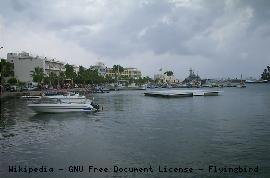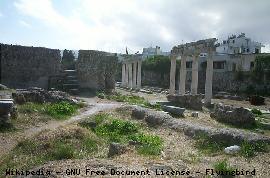This is an old revision of this page, as edited by 212.205.209.16 (talk) at 14:44, 2 July 2006. The present address (URL) is a permanent link to this revision, which may differ significantly from the current revision.
Revision as of 14:44, 2 July 2006 by 212.205.209.16 (talk)(diff) ← Previous revision | Latest revision (diff) | Newer revision → (diff) For other uses, see Kos (disambiguation).




Kos or Cos (36°51′N 27°14′E / 36.850°N 27.233°E / 36.850; 27.233, Greek Κως) is a Greek island in the Dodecanese group of islands, in the Aegean Sea, which it separates from the Gulf of Cos. It measures 40 km by 8 km, and is only 4 km from the coast of Bodrum in Turkey. The island has both fertile plains and infertile highlands. Population: 30,500. Other names of the island include: Turkish İstanköy, Italian Coo; formerly Stanchio in English.
The island boasts long sandy beaches with large hotels and secluded villages, leading to its main industry being tourism. Farming is the principal occupation of many of the island's inhabitants, with their main crops being grapes, almonds, figs, olives, and tomatoes, along with wheat and corn. Cos lettuce may be grown here, but the name is unrelated.
The main port and population centre on the island, also called Kos, is also the tourist and cultural centre, with whitewashed buildings including many hotels, restaurants and a small number of nightclubs forming the famous Kos town "barstreet". The town has a 14th century fortress at the entrance to its harbour, erected in 1315 by The Knights of Saint John of Rhodes. The ancient physician Hippocrates is thought to have been born on Kos, and in the center of the town is the Plane Tree of Hippocrates, a Dream temple where the physician is traditionally supposed to have taught. The limbs of the now elderly tree are supported by scaffolding. The small city is also home to the International Hippocratic Institute and the Hippocratic Museum dedicated to him.
The main villages of Kos island are Kardamena, Kefalos, Tigaki, Antimachia, Mastihari, Marmari and Pyli. Smaller ones are Zia, Zipari, Platani, Lagoudi and Asfendiou.
Kardamena is now a popular resort for young British holidaymakers and has a large number of bars and nightclubs.
History
The island was originally colonised by the Carians. The Dorians invaded in the 11th century BC and joined the Athenian Federation, expelling the Persians twice. In 366 BC the town of Kos was built, then soon after the island became a part of the Roman Empire, then the Byzantine Empire. The island was conquered by the Venetians, who then sold it to The Knights of Saint John of Rhodes. Two hundred years later the Knights faced the threat of a Turkish invasion, and so abandoned the island. The Ottoman Empire ruled Kos (Turkish 'İstanköy'; in English usage, 'Stanchio') for 400 years until it was transferred to Italy, who used the name 'Coo', in 1912. In World War II, the island was taken over by Germany, until 1945, when it became a protectorate of Britain, who ceded it to Greece in 1947.
External references
- Kos island directory: Kos island official directory
- Kos: Kos official site (Not updated)
- Kos island Greece: Kos Island information
- Kos travel guide: Kos travel site
- The Engravings of Kos by Alekos J. Markoglou
- Kos Town Photos and Reviews